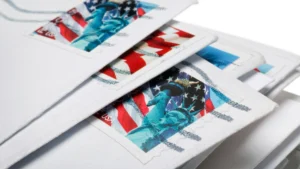Direct mail and the various types of mailing options available, remain a cornerstone and effective marketing strategy, offering businesses a tangible way to connect with their target audience. The United States Postal Service (USPS) provides a variety of direct mail options tailored to different business needs—from postcards and letters to political campaigns and nonprofit mailings. To ensure the success of your campaign, it’s essential to understand the different types of mail, their postage rates, and related services like USPS Every Door Direct Mail (EDDM). This comprehensive guide explores these options in detail, offering insights into size requirements, postage rates, and best practices.
Types of Direct Mail
1. Postcards
Postcards are among the most cost-effective and versatile direct mail options. They are ideal for short messages, promotions, or reminders, providing businesses with an easy way to reach their audience without a significant expense.
Postage Options:
- First-Class Mail Postcards: $0.51 per piece (as of 2024). This rate applies to postcards that meet specific size criteria and ensures faster delivery, typically within 1-3 business days.
- Presorted First-Class Mail: Postcards mailed at this rate must be sorted by ZIP code before mailing, offering a slightly lower postage rate than standard First-Class Mail, particularly for larger quantities.
- Standard Mail (Marketing Mail): For larger quantities, Standard Mail (formerly known as Bulk Mail) is a cost-effective option. Rates vary based on the mailing volume and the level of sorting but can be as low as $0.18 per piece. Delivery typically takes 5-7 business days.
Size Requirements:
- Minimum Size: 3.5 inches high x 5 inches long x 0.007 inches thick.
- Maximum Size: 4.25 inches high x 6 inches long x 0.016 inches thick.
Postcards exceeding these dimensions are classified as letters and will incur higher postage rates.
2. Letters
Letters provide more space for detailed information, making them suitable for formal communications, fundraising appeals, or personalized messages. They can include enclosures such as brochures, response cards, or promotional items.
Postage Options:
- First-Class Mail Letters: $0.66 per piece for letters up to 1 ounce (as of 2024). Delivery typically occurs within 1-3 business days.
- Presorted First-Class Mail: Offers a lower rate than regular First-Class Mail, particularly for larger mailings. Requires sorting by ZIP code and a minimum mailing volume.
- Standard Mail (Marketing Mail): Rates for presorted Standard Mail start at approximately $0.19 per piece, depending on sorting level and mail volume. Delivery times are generally longer, around 5-7 business days.
Size Requirements:
- Standard Letter Size: Up to 6.125 inches high x 11.5 inches long x 0.25 inches thick.
- Weight Limit: Up to 3.5 ounces for First-Class Mail rates.
Letters are highly customizable and can be tailored with variable data printing, enabling personalized content for each recipient.
3. Self-Mailers
Self-Mailers are unfolded mail pieces that do not require an envelope. They are often used for marketing materials like brochures or promotional flyers and must be securely sealed to meet USPS guidelines.
Postage Options:
- First-Class Mail: Pricing is similar to standard letters, with rates starting at $0.66 per piece.
- Standard Mail: For larger volumes, presorted Standard Mail offers a lower rate, often between $0.18 and $0.25 per piece, depending on the specifics of the mailing.
Size Requirements:
- Standard Self-Mailer Size: Up to 6 inches high x 10.5 inches long x 0.25 inches thick.
- Weight Limit: Typically up to 3 ounces.
Self-mailers are ideal for businesses that want to include more information than a postcard can hold while avoiding the higher costs associated with letters.
4. Flats
Flats are larger than standard letters and are often used for items like magazines, newsletters, or catalogs. They offer ample space for businesses to include detailed information, images, and multiple products.
Postage Options:
- First-Class Mail Flats: Starting at $1.35 per piece (up to 1 ounce), with each additional ounce costing extra.
- Standard Mail Flats: Presorted Standard Mail rates are lower, often starting around $0.40 per piece, depending on the volume and level of sorting.
Size Requirements:
- Standard Flat Size: Up to 12 inches high x 15 inches long x 0.75 inches thick.
- Weight Limit: Up to 13 ounces for both First-Class and Standard Mail.
Flats are particularly effective for marketing campaigns that require more detailed product information or visual elements.
5. Catalogs
Catalogs are a specialized type of flat mail designed to showcase a company’s products or services. They are particularly effective for businesses with a wide range of offerings and can be a powerful tool for driving sales.
Postage Options:
- Standard Mail Catalogs: Presorted Standard Mail rates for catalogs are similar to flats, generally starting around $0.40 per piece. Bulk rates are available for large volumes.
- First-Class Mail: If faster delivery is required, First-Class rates apply, starting at $1.35 per piece.
Size Requirements:
- Standard Catalog Size: Same as flats, but can be thicker to accommodate multiple pages.
Catalogs are often kept by recipients for future reference, making them a valuable tool for maintaining brand visibility over time.
6. Political Mail
Political Mail is a category of direct mail specifically designed for political campaigns. It allows candidates and advocacy groups to communicate directly with voters.
Postage Options:
- First-Class Mail: Offers faster delivery, typically within 1-3 business days, with rates starting at $0.66 per piece.
- Standard Mail: For larger mailings, Standard Mail offers lower rates, often around $0.18 to $0.30 per piece, depending on volume and sorting.
Size Requirements: Political Mail can be sent as postcards, letters, flats, or parcels, depending on the message and budget.
Political Mail is highly effective for targeting specific voter demographics and geographic areas, especially during election periods.
7. Nonprofit Mail
Nonprofit Mail is a discounted rate available to qualified nonprofit organizations, making it an affordable option for fundraising, membership drives, and awareness campaigns.
Postage Options:
- Standard Nonprofit Mail: Rates are significantly lower than commercial rates, often as low as $0.12 to $0.16 per piece, depending on the specifics of the mailing.
Size Requirements:
- Similar to Standard Mail: Nonprofit Mail follows the same size and weight requirements as Standard Mail, but with discounted rates.
Nonprofit Mail enables organizations to reach their audience effectively while keeping costs low, making it a vital tool for community outreach and fundraising efforts.
8. Every Door Direct Mail (EDDM)
Every Door Direct Mail (EDDM) is a USPS service that allows businesses to reach every address within a specified geographic area without needing a mailing list. This service is ideal for local businesses, real estate agents, restaurants, and service providers.
Benefits of EDDM:
- No Mailing List Required: EDDM targets every address within selected ZIP codes or neighborhoods, ensuring comprehensive coverage.
- Lower Postage Rates: EDDM rates are lower than standard mail rates, starting at $0.20 per piece, making it a cost-effective option for large-scale mailings.
- Flexible Size Options: EDDM allows for a variety of mailpiece sizes, including oversized postcards, brochures, and flyers.
Size and Weight Requirements:
- Maximum Size: 12 inches high x 15 inches long x 0.75 inches thick.
- Weight Limit: Up to 3.3 ounces per piece.
How to Use EDDM: Businesses can use the USPS EDDM Online Tool to select target areas, choose the delivery date, and print the necessary forms. This service is ideal for promoting local events, special offers, or grand openings.
Understanding Postage Rates and Options
1. First-Class Mail:
- Delivery Speed: Typically 1-3 business days.
- Use Cases: Ideal for time-sensitive materials such as invoices, correspondence, or promotional offers.
- Rates: $0.51 for postcards, $0.66 for letters up to 1 ounce, $1.35 for flats up to 1 ounce.
2. Standard Mail (Marketing Mail):
- Delivery Speed: 5-7 business days.
- Use Cases: Best for large-volume mailings that are not time-sensitive, such as promotional materials and catalogs.
- Rates: Generally between $0.18 and $0.40 per piece, depending on sorting and volume.
3. Presorted Mail:
- Delivery Speed: Similar to First-Class or Standard Mail, but with lower rates due to sorting requirements.
- Use Cases: Ideal for businesses with larger mail volumes that can sort mail by ZIP code.
- Rates: Slightly lower than standard rates, offering savings for bulk mailings.
4. Nonprofit Mail:
- Delivery Speed: Similar to Standard Mail.
- Use Cases: Designed specifically for qualified nonprofit organizations, offering significant savings.
- Rates: Generally between $0.12 and $0.16 per piece.
5. Every Door Direct Mail (EDDM):
- Delivery Speed: Typically 2-5 business days.
- Use Cases: Perfect for local businesses wanting to reach every household or business in a specific area without the need for an address list.
- Rates: Starts at $0.20 per piece, making it one of the most cost-effective ways to conduct large-scale mail campaigns.
6. Bulk Mail:
- Delivery Speed: 5-10 business days.
- Use Cases: Best for non-urgent, high-volume mailings such as flyers, promotional materials, and catalogs.
- Rates: Vary widely depending on volume, weight, and sorting level, with significant discounts for higher volumes.
Maximizing Your Direct Mail Campaign Types with USPS
To ensure the success of your direct mail campaign, it’s important to follow USPS guidelines and take advantage of the services they offer. Here are some additional tips for optimizing your campaign:
- Use USPS Tracking: Adding tracking to your mailpieces allows you to monitor delivery and measure the effectiveness of your campaign.
- Consider Using PURLs or QR Codes: Personalized URLs (PURLs) and QR codes can be added to your mailpieces to direct recipients to a specific landing page, allowing for better tracking and engagement.
- Schedule Mailings Strategically: Plan your mailings to coincide with key dates or seasons to maximize impact.
- Take Advantage of USPS Discounts: Look for special USPS promotions or discounts, particularly during peak mailing seasons.
Types of Direct Mail Conclusion
By understanding the different types of direct mail and how to use them effectively, businesses can create campaigns that resonate with their audience and drive tangible results. Whether you’re sending postcards, letters, or utilizing the EDDM service, USPS offers a variety of tools and options to help your direct mail campaign succeed.
If you would like to learn more about our direct mail services, visit our Direct Mail Page: Click Here
If you are interested in our help, or would like to receive a quote for your next direct mail campaign, click “Get Printing” below to get started today:




